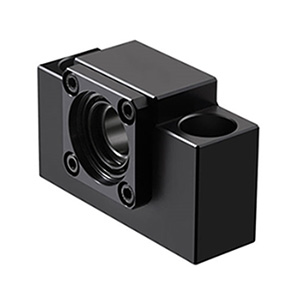Ball Screw Bearing Selection Guide
Ball screw bearings are an essential component of ball screw assemblies, which are used to convert rotary motion into linear motion in a wide range of industrial applications. Choosing the right ball screw bearing is crucial to ensure the reliable and efficient performance of the assembly. In this blog, ATO will discuss some important factors to consider when selecting a ball screw bearing.

The picture shows the 15mm ball screw bearing with a shaft diameter supplied by ATO, with low price, high quality bearing steel, strong bearing capacity, and accuracy class C5. Widely used in the aerospace industry, used in antenna actuators, valve switchgear, etc.
1. Determine diameter based on load
The output torque is included in the performance parameters of the motor. If it is equipped with a reducer, it should also be included (considering the efficiency). Calculate how much thrust is required in the actual working condition. The ball screw bearing sample (required from the manufacturer) has load parameters (thrust parameters, Generally marked as dynamic load and static load, just look at the former), and select the nominal diameter of the ball screw bearing.
2. Determine the lead of the ball screw bearing based on the linear and rotational speeds
The output speed is known when the motor is determined. Consider the maximum linear speed you need. Multiply the motor speed (if it has a reducer and then divide it by the reduction ratio) by the value of the screw bearing leading to getting the linear speed. If this value is greater than the required value, it is acceptable.
3. Determine the length of the ball screw bearing based on actual requirements
Total length = working stroke + nut length + safety margin + installation length + connection length + margin. If protection is added, such as a sheath, the telescopic ratio of the sheath (generally 1:8, that is, the maximum elongation of the sheath divided by 8) needs to be taken into account.
4. Determine the precision of the ball screw bearing based on actual requirements
Generally, C7 or below is sufficient for mechanical applications, and C5 is more commonly used for CNC machine tools (refer to the sample for specific details).
5. Determine the form of ball screw bearing nuts based on installation conditions and dimensional structures
Nuts have many structures. Different nuts have slightly different structures and sizes. Choose according to the situation. It is recommended not to choose too special ones. It is not easy to repair and replace parts in case something goes wrong.
6. Inquire about the price, payment terms, and delivery time from the selected manufacturer
Designers should not think that this is only a matter of procurement. In fact, many manufacturers (both domestic and imported) may not produce certain models or accept small orders, even though these models are listed in their product samples. Don't wait until you have selected and completed the drawings for other parts to start purchasing, only to find out that the delivery time for this model is 3-4 months.
7. Determine the installation method (end)
This installation part can be designed by yourself or purchased as a finished product. Standard mounting bases are available for selection. Pay attention to the stress state when designing, and it is best to choose 7000 or 3000 series bearings, as ball screw bearings mainly bear axial forces during operation, and radial forces should be avoided as much as possible.
8. Consider the guiding parts and installation capability
It is recommended to choose a ball linear guide that matches the ball screw bearing. Of course, the combination of a linear shaft and linear bearing is a relatively economical choice.
In conclusion, choosing the right ball screw bearing is crucial to ensure the reliable and efficient performance of the ball screw assembly. When selecting a ball screw bearing, it is important to consider factors such as load capacity, accuracy, speed, noise, environment, and cost. By carefully considering these factors, you can select a ball screw bearing that meets the performance requirements of your specific application while also being cost-effective.
Ball screw bearings are available in six versions, BK, BF, EK, EF, AK, and AF, which are sold in the ATO online store with high precision and stable rotational performance. Welcome to purchase.

